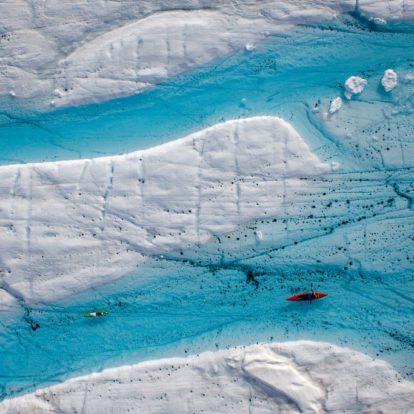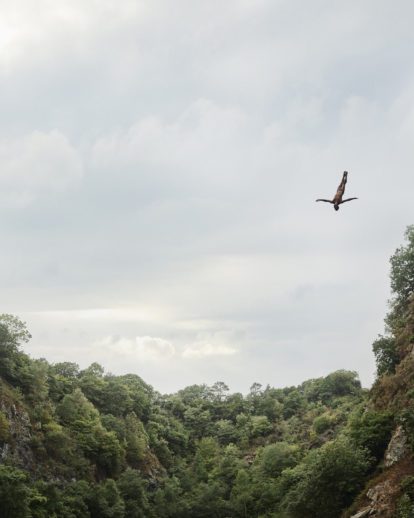Northern Laos’ Plain of Jars is a stark, other-worldly vista of vivid-green hills scattered with thousands of what are thought to be funerary urns placed there by an ancient race during the Iron Age. There’s a palpable sense of mystery as you look through the mist at these giant stone jars, a sense of connection with an ancient civilisation whose thoughts and motivations have long been forgotten. One story goes they were used by a race of giants as receptacles for rice wine, so they could celebrate an illustrious military victory.
Yet there is also a more recent and sinister military history here, the most obvious indications of which are the ubiquitous warnings to keep to specified paths because of the threat of unexploded ordnance. Take a look from the air and you’ll see today’s duck ponds are actually recycled bomb craters, the ground ulcerated as if struck by a meteor shower. In the nearby town of Phonsavan, you’ll observe huge shell casings reused as flower planters, or as supports for stilted houses by the padi fields. You’ll also notice people without limbs. Plenty of them. Just over a half century ago, Laos was caught up in a war that America conducted in absolute secret. From 1964 to 1973, it ran aerial bombing campaigns to support the Royal Lao Government against the communist Pathet Lao. Overall, two million tonnes of bombs were dropped on Laos, most intensively on Phonsavan and the nearby Lao-Viet border, where the Ho Chi Minh Trail (secret artery supplying soldiers and munitions to Vietnam) meandered into Xieng Khuang Province.
The perceived threat of the Cold War and spread of global communism in the 1960s was the justification cited by the U.S for their ill-fated meddling in Southeast Asian affairs. There was, and is, no defence however, for the fact that Laos was regarded by American forces as little more than a dumping ground for live, unemptied payloads from the bellies of B52s returning after fly-bys on the trail. Rather than re-number each shell by hand it was easier and safer to indiscriminately jettison them. Tragically, around 30% never exploded on impact, and consequently every monsoon, despite the best efforts of mine-clearing outfits like MAG (Mines Advisory Group), the problem rears its head when heavy rains bring unexploded ‘bombies’ (squash ball-sized explosives dropped from cluster bombs) to the surface, claiming yet more lives.
I visited Laos in 2002 to investigate a yet more hidden aspect of the Secret War that also carries consequences today. My destination was Xaisomboun Province (aka the Special Zone), which had been officially sanctioned as off-limits by the Lao government in 1994. At the time, nobody from the West had been in there for eight years. There were stories of a lost group of veteran soldiers awaiting the return of U.S. Forces who had deserted them in 1975 – the indigenous Hmong, who had risked everything to join the fight against communism, and had ended up condemned to a life of persecution. The Hmong tribe are just one of over a hundred ethnic minorities in Laos. Handsome and self-possessed, with an instinct for business, they are an itinerant people originally expelled from China, who to this day practice slash and burn farming, and were responsible for industrial amounts of opium being grown in the Laotian highlands. Back in the 60s they had a reputation for being as tough as ironwood, and with their natural distrust of communism they made for a dependable US ally. After the communists won the civil war, the Lao People’s Revolutionary Party made it abundantly clear that they would have no mercy for their enemies, proclaiming in 1975 that those who had collaborated with the Americans would be ‘butchered like animals’. Generations later the government has still not relented in a campaign described by many human rights groups as ethnic cleansing.
Back in 2002 I couldn’t find anyone as outraged as myself by the alleged ethnic cleansing going on in Laos. Correction, I couldn’t find anyone – period – who knew anything about the issue save the website I had stumbled on whilst researching another project. What I read disturbed me sufficiently to call Reuters, who informed me the country was a black hole of non-disclosure, and that foreign journalists if caught there would be slung in jail. They knew nothing of the plight of the Hmong. Why not? I wondered.
I decided to fly to Laos’ low-slung capital, Vientiane, a wicked brew of dark bars, Soviet architecture, crumpled roués and French bakeries, to find out. My ex-Washington Post contact had sadly died, the owner of the Scandinavian Bakery duly informed me as he wiped flour from his hands. An old photo tacked to the wall showed him and the Politburo cosying up over a prize gateau he’d created. It made sense to keep in with the Party then – it still does today. Money opens doors, while a lack of it keeps them closed.
Two days of asking questions ensued, but I’d gotten nowhere – nobody knew a thing about the Hmong guerillas, or if they did no one was willing to talk to me. ‘You have to be careful,’ a lady who ran a shop whispered to me, ‘People disappear here.’ I caught a flight to Phonsavan with a view to making my way south from there into the Special Zone. The sky was pregnant with panther-black clouds as the twin-prop banked east of Phu Bia (Laos’ tallest mountain) lurching blindly through the mist-laced crags without radar.
In Phonsavan itself I found myself sharing a dirt-cheap Politburo-style suite with a nest of cockroaches. The first person I’d met on arrival was a teenage kid touting himself as a guide. I was in the country to ask questions people didn’t want to answer about a war they’d put behind them, and a government they were afraid to talk about, and the kid had good English. But I couldn’t have chosen a worse candidate, for I soon discovered his father was head of the local Communist party.
From a village close to the Plain of Jars I could see the green wall of distant jungle that signalled the edge of the Xaisomboun Province. I needed someone with local knowledge to help smuggle me in there. Back in town, I had the sense I was being tailed in the dry goods market. I had reason to be paranoid, in my rucksack was a cache of incriminating emails from a Hmong contact living in the large ex-pat community now based in Fresno, California. It detailed a Hmong village on the west side of the Special Zone that had allegedly been firebombed by Viet gunships a few days before, acting on behalf of the Lao government.
‘In Phonsavan itself I found myself sharing a dirt-cheap Politburo-style suite with a nest of cockroaches.’
Richard Waters
I possessed neither a detailed map, nor anyone to back me up if it all went south, save Daniel Alberman, a southeast Asian specialist at Amnesty International. We’d agreed that the night before I entered the Special Zone I would alert him, and then call him no later than 24 hours later to let him know I had made it out without capture. Failure to contact him before the allotted deadline would result in his raising the alarm on my behalf at the Foreign Office. I hoped that would be enough time to get in and out.
In Phonsavan, I bid farewell to the cockroaches and switched to a hostel run by an intelligent Lao called Kong who warned me: ‘You can’t get in to Xaisomboun from Phonsavan, too many soldiers… you’ll have to find another way in.’ I was crestfallen, but it was just the local knowledge I needed. By now the Special Zone had morphed into a kind of Mordor in my imagination and I was heading there as blindly as Frodo to Mount Doom. The most crucial information came from a German contact I bumped into by coincidence a few days later: ‘The road you need to take is an Army road called 13B, it’s not far from Vang Vieng. You’ll need a map from the Geographic Society in Vientiane. If the army catch you though, they’ll shoot you on sight. Nobody has been in since it was sealed off in ’94.’
One of the prospects that excited me most about going inside the zone was that I would see ‘Long Tieng’, once described as ‘the most secret place on earth’. I’d heard there was a Laotian military base there these days, but during the civil war it was run by the CIA and with a population of 40,000 made up of Americans, Thai military and Hmong, was the second largest city in Laos, as well as having one of the busiest runways in the world. Naturally, it didn’t exist ‘officially speaking’, just as Congress in Washington had no idea there was even a clandestine war being fought in Laos. Allegedly the old runway built and used by the CIA was still there. Having travelled almost six thousand miles and come this far though, I wasn’t going to back out now, I was as curious as I was scared.
Back in Vientiane a visit to the Geographic Society produced an impeccably detailed map. The German was right, there was a way in, but wasn’t it too obvious, they’d surely see and hear me coming from a mile away? It was still dark, the dawn an hour away when I climbed on the white Yamaha, its front forks gleaming gold like the gilded temple rooves on Setthathirath Street. The journey to 13b alone would take me three hours of hard riding up into the mountains, and from there another five hours to the firebombed village.
As dawn rose across wet rice padi, the first farmers sleepily leading their buffaloes to their yokes, I stopped at the roadside and bought some sticky rice. I was shivering, unsure whether it was the cold or my fear. Part of the route followed close beside the beautiful Nam Ngum reservoir, a huge turquoise lake punctuated by an archipelago of white sandbars. And then mid-morning, there I was at the turn off for 13b: no gate, no sentry, no sign to the Special Zone, just a burnt-orange road that led toward more mountains. I gunned the bike and crossed my Rubicon. Imagine soaring limestone peaks, endless forest and verdant valleys dissected by rivers; the feeling of being somewhere vast and pristine, untouched by travellers. There were little hamlets every few miles, each with a sentry post and either a sleeping guard, or no guard at all.
I was short on time but I rode the extra miles to witness Lima Site 20A, aka Long Tieng airbase, in the valley far below. At the end of the 1260 metre-long runway was a clutch of pyramid-shaped limestone karsts known back in the day as the ‘vertical speed brake’. There were shacks and a market with a corrugated tin roof, plus an army base. Looking down at the old airfield I tried to imagine how busy it had once been playing host to a constant carousel of Ravens, the maverick forward air controllers who flew perilously close to the forest canopy in their brittle Cessnas, and the awful lumbering B52s returning empty-bellied. For all its present decrepitude, it had once been a launch-pad to thoughtless murder and suffering. Beside an empty watchtower I measured my current progress on the map: I still had a further three hours to get to the bombed village of Thathom yet already the sun was on the wane. In my adrenalized state, I’d been in the Special Zone for hours without realising it. I rode on.
At the foot of a mountain I could see a base of sorts, a few long buildings and a central administration block with a smaller building beside it (probably an armoury). Nearby, pretty as a silk screen print, a river flowed around a limestone karst. I cracked off a couple of shots on my camera, suddenly spooked by something moving behind me, then shook off the paranoia and headed down the hill for my first face-to-face with the army. Instead of racing by the base I slowed down and ambled by with a wave. Someone shot up from a hammock and barked an order, and within moments a troop of soldiers in their underpants had surrounded me with wood-stock rifles and machine guns. One man laughed, pointed at me, then the road and shook his head. Judging by the way the other men deferred to him he was in charge, and so was naturally the first person I gave a cigarette to. Clearly, he considered me stupid and, given that I had driven straight into Xaisomboun on a noisy motorbike, anything but a threat to national security. Behind my mud-caked smile my heart was going ten to the dozen. Were these men capable of the brutalities I had read about; raping Hmong women and brutally disembowelling their children? The boss man and I smoked our cigarettes, some of the men looked at the bike admiringly and asked if they too could have a smoke. Smiles all round, it didn’t look as if they were going to shoot me. I climbed on the Yamaha and continued toward Thathom. A few months after I’d returned to the UK, three European journalists were caught close by the base where I’d been stopped. Not so lucky, they had been stripped, hung upside down and beaten with motorcycle chains before being tossed in jail without a fair hearing.
‘One of the prospects that excited me most about going inside the zone was that I would see ‘Long Tieng’, once described as ‘the most secret place on earth’.
Since that trip my understanding of the country has deepened over fifteen odd years of working there; this is a country with a memory like an elephant. I’ve met many Hmong and find them to be an intelligent people with a fun sense of humour and strong sense of spirit. Why would the government still have such a bee in their bonnet over this raggle-taggle group of ineffectual guerrillas? Being the first in to that stunningly beautiful landscape was not important to me, doing something about what was happening there was my first concern. I knew I’d been lucky thus far and having carried on toward my destination after the soldiers let me go, it was common sense that urged me to turn the bike around and get out as quick as I could. I subsequently provided the BBC with intelligence that gave them sufficient curiosity to send one of their journalists in in 2003, while in 2004, shutterbug Philip Blenkinsop made it to the Hmong guerilla’s secret camp, his black and white photos for Time magazine, a harrowing narrative of a lost people spanning three generations, many with missing limbs and eyes, living in near starvation and constant fear. This same year as I was preparing to go back in to the zone (with much improved intel and a specialist guide to take me straight to the jungle hideout), my son was born. Smarting over the double insult of a documentary and photo shoot happening under their noses, the government had beefed up the military presence even more than usual. Back in Brighton, looking at this little blonde tot in his sleepsuit, curled up asleep in his cot, I realised there was no need to go back; I had started the wheels in motion by taking the story to the BBC. Their journalist who had gone in with a cameraman was now lobbying the Senate in Washington while Blenkinsop’s pics had caused a suitable stir. The story of the Hmong was out there in the public domain. And my little boy needed a father.
For the tourist, Laos is a magical and peaceful place where you can stay in former French colonial houses revived as boutique hotels, ride an elephant, eat fantastic food and go trekking. But for Laotians advocating social change who dare to raise their head above the parapet it is still as dangerous as it was fifteen years ago. Sombath Somphone, an acclaimed community development worker who disappeared in 2012 is still missing, and despite CCTV footage providing proof that he was abducted by the police, not to mention considerable international pressure, the Lao government denies any responsibility. Tiger farms continue to flourish in Laos for the benefit of wealthy Chinese businessmen willing to pay astronomical fees to partake of the animal’s testicles and other body parts while gambling in Lao casinos in the Golden Triangle. At the beginning of 2017 the army was still targeting Hmong hiding out in the Special Zone with long and short-range devices, including chemical weapons. My grandfather’s lungs were scored by exposure to mustard gas in the trenches of the First World War, it confounds me to think that it is still happening today in Xaisomboun. Until these problems are settled, they will remain as explosive as all those unexploded ‘bombies’ lurking under the surface.









